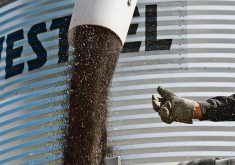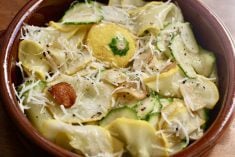I was introduced to barley flour a few years ago when a group of farmers in our area were planning a barley flour business. I was one of several people who tested the flour in recipes.
I remember how we liked its nutty flavour in the breads we were testing. The business did become a reality and Golden Grains Farm Co. Ltd. at Dinsmore, Sask., now supplies barley flour, barley cereal and rolled barley to grocery and health food stores in our area and beyond.
How does barley flour differ from wheat flour?
Read Also

Alberta cracks down on trucking industry
Alberta transportation industry receives numerous sanctions and suspensions after crackdown investigation resulting from numerous bridge strikes and concerned calls and letters from concerned citizens
We have experience baking with wheat flour, either in whole grain form or the further processed, all-purpose form. The barley flour on the market is a whole grain flour, which makes it more similar to whole wheat flour than to all-purpose flour.
However, barley flour does not have the same heavy texture that you usually associate with a whole grain flour. It is easily substituted for all-purpose flour in most recipes, with the exception of bread. A word of advice from Golden Grains when baking with barley flour is to use less than you would with wheat flour. Overbaking barley flour products tends to give a dry texture.
Yeast-raised barley flour bread
Barley is low in gluten and would make a heavy bread if you did not also add wheat flour to the recipe. Yeast-raised products like bread need strong gluten in order to rise and create the texture we like. A ratio of no more than one-third of the flour being barley should be used for best results.
You might want to start with a lower percentage of barley flour at first, such as, one cup (250 mL) barley flour to six cups (1.5 L) white wheat flour.
You may wish to add a product called vital wheat gluten for a higher volume bread. This is sold by the box in the baking ingredient section at your supermarket.
One big advantage to barley flour and other barley products is that they do not require refrigeration. In its natural form, barley contains an anti-staling agent.
Barley has been used as a human food for thousands of years. Only in the last decade, have we started to use it in many different ways. Hulless varieties have made barley food use more attractive because the hull is easily removed during harvesting, similar to wheat.
Reasons to eat more barley:
- Barley is one of the richest sources of fibre. It has both soluble and insoluble fibre. Wheat is low in soluble fibre, so baking with barley flour is one way to increase soluble fibre in your diet. Barley fibre is also hydroscopic, meaning it has water-holding capacity that aids in gastro-intestinal function. North Americans consume only about 14 grams of fibre per day, but nutritionists recommend 25-35 grams per day.
- Barley has components that can inhibit fat and cholesterol absorption in the intestine. This results in lower blood cholesterol, especially the LDL or harmful form.
- It is low in fat.
- Barley is an excellent source of complex carbohydrates.
- Barley tastes good and adds variety to your menu. Canada’s Food Guide suggests five to 12 servings of grain foods each day. Barley is a healthy choice.
- Barley is a comfort food that can fill you up and delay feelings of hunger.
Barley products on the market
Barley is available in different forms:
- Whole grain barley flour can be substituted for wheat flour in many recipes, including muffins, cakes, cookies and quick breads.
- Barley flakes are a good alternative to rolled oats in some recipes and make a good cereal.
- Whole barley is usually a hulless variety that can be soaked, cooked and then used as a tasty and wholesome addition to meals or as an ingredient in casseroles.
- Pot and pearl barley are used in soups, stews, casseroles and salads. You might ask, what is the difference between pot and pearl barley? The answer is that barley kernels are polished, or pearled, to remove the inedible hull part of the grain. Pearl barley is polished more than pot barley, hence its smaller size. Which kind you prefer is a matter of taste. The pearl barley cooks a bit faster than the pot barley, which takes about 40 minutes, and is more often used in foods where a smaller cooked kernel size is preferred, such as in salads and puddings.
Barley bread dough
This recipe uses 50 percent barley, more than the recommended 30 percent. However, the combination of ingredients used make it a nice bread.
41Ú2 cups warm water 1.125 L
1Ú3 cup oil 75 mL
1Ú3 cup honey or white sugar 75 mL
1 (rounded) tablespoon 15 mL
traditional dry yeast
1-2 tablespoons salt 15-30 mL
1Ú4 teaspoon vitamin C/ascorbic 1 mL
acid (crushed tablet helps
activate yeast)
8 cups white flour 2 L
4 cups barley flour 1 L
In a large bowl mix together water, oil and honey. Then add four cups (one L) of the white flour and two cups (500 mL) of barley flour. Mix until moist.
Next add yeast, salt and vitamin C, and mix. Gradually add remaining flour Ñ four cups (one L) white flour and two cups (500 mL) of barley flour Ñ and mix until dough begins to leave the side of the bowl.
If you are using an electric mixer with bread hook, mix for four minutes.
It is better if the dough is a little sticky. If you are kneading dough by hand, add a little more flour to dough so it can be easily worked with hands.
Put dough on a lightly floured board and knead for five minutes. Place on an oiled area on a counter. Shape dough into a round ball and place in a large greased bowl. Cover dough with plastic wrap and towel. Set bowl in a warm location and let rise until it just doubles.
Remove dough from bowl and shape into four small loaves of bread, or fruit bread or 31Ú2 dozen buns or cinnamon buns, or a combination of all four.
For bread, place loaves in greased loaf pans.
For buns, place on greased cookie sheets or in muffin tins.
For fruit bread, add glazed fruit and plumped raisins to dough before shaping into loaves. I used 1Ú2 cup (125 mL) of fruit and
raisins per loaf. Add more if you like.
For cinnamon buns, roll out dough into a rectangular shape. Brush dough with butter. Sprinkle on brown sugar, cinnamon and plumped raisins. Roll up dough into a log, starting with the longer side of the rectangular dough. Cut into one inch (2.5 cm) slices. Place on greased baking pans.
Let dough rise for 30 minutes or until doubled in size.
Bake in 350 F (180 C) oven. Cinnamon buns can be sprinkled with brown sugar and cinnamon before baking. Bake buns and cinnamon buns for approximately 20 minutes or until lightly browned. Loaves will take about 30 minutes.
To plump raisins, pour hot water over raisins, let stand five minutes and drain.
Joe’s barley pancakes
1 cup white flour 250 mL
1Ú2 cup barley flour 125 mL
1 tablespoon baking 15 mL
powder
1Ú2 teaspoon salt 2 mL
3 tablespoons sugar 45 mL
2 eggs, separated
11Ú2 cups milk 375 mL
3 tablespoons melted 45 mL
butter
1Ú4 teaspoon vanilla 1 mL
Mix and sift dry ingredients. Beat egg yokes and add the milk. Add eggs and milk to dry mixture. Add melted butter and vanilla. Fold in beaten egg whites. Cook and enjoy.
Barley peanut butter cookies
1Ú2 cup white sugar 125 mL
1Ú2 cup brown sugar 125 mL
1Ú2 cup butter or margarine 125 mL
1 egg
2Ú3 cup peanut butter 150 mL
11Ú2 cups barley flour 375 mL
1Ú2 teaspoon baking powder 2 mL
1Ú2 teaspoon baking soda 2 mL
1Ú4 teaspoon salt 1 mL
In one bowl, cream sugars and butter. Then whip in the egg and peanut butter. In a separate small bowl, combine and mix the remaining ingredients. Add the flour mixture to the peanut butter mixture. Roll batter into one inch (2.5 cm) sized balls and place on a greased cookie sheet. Press each cookie down with a fork. Bake at 350 F (180 C) for 10-12 minutes or until lightly browned. Makes approximately 21Ú2 dozen cookies.
Source: The above recipes were developed by Golden Grains Farm Co. Ltd. For more information about recipes or barley products, contact them at Box 503, Dinsmore, Sask., S0L 0T0, 306-846-4722 or fax 306-846-4345.
Another source of barley information is the Alberta Barley Commission, #200, 3601AÐ21 Street N.E., Calgary, Alta., T2E 6T5, 403-291-9111, fax 403-291-0190.
Household hint
Thanks to M. B. of Melville, Sask., for this week’s household hint.
“When cleaning oven racks, I use a barbecue bristle brush, one that has the little notches on the side that will go along the rack to clean off items that get burned on. The stiff bristles work well overall. Even if you have a self-cleaning oven, it is recommended that you do not leave the racks in because they tarnish.
It is still not a fun task, and takes time and patience.”
Alma Copeland is a home economist from Elrose, Sask., and one of four columnists comprising Team Resources. Send correspondence in care of this newspaper, Box 2500, Saskatoon, Sask., S7K 2C4 or contact them at team@producer.com.














